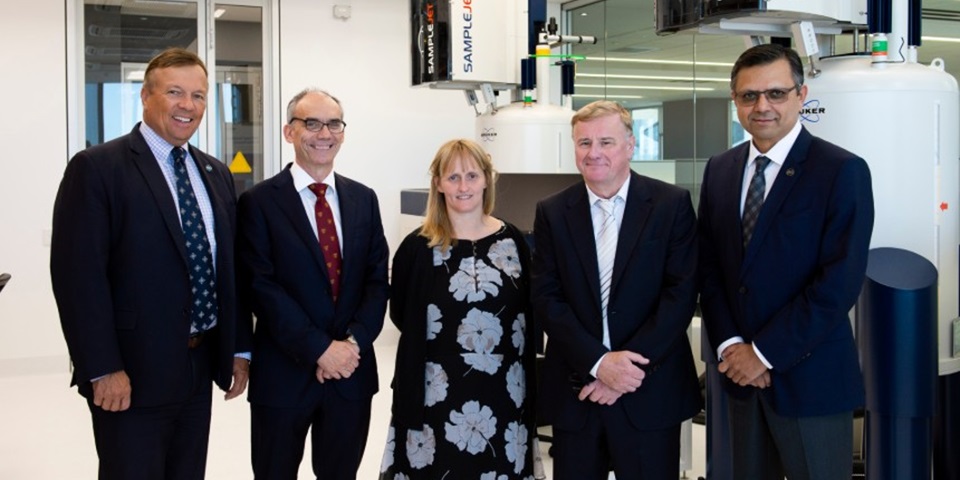News
Strategic Alliance between Murdoch University and Bruker Supports International Centre of Excellence in Metabolic Phenotyping

Murdoch University and Bruker Corporation (Nasdaq: BRKR) today launched a strategic alliance that will help to transform the prevention and diagnosis of disease and personalised health around the world.
The Murdoch University-Bruker Corporation alliance will play a key role within the Australian National Phenome Centre (ANPC), the international centre for expertise in metabolic phenotyping, which is to be launched 4 October 2019.
The ANPC has been established under the leadership of Murdoch University Pro Vice Chancellor for Health Sciences and international pioneer in metabolic phenotyping, Professor Jeremy Nicholson, and distinguished computational biologist and 2018 WA Premier’s Fellow in Phenomics, Professor Elaine Holmes.
Equipped with Bruker Corporation nuclear magnetic resonance (NMR) and mass spectrometry (MS) solutions, including the largest collection of mass spectrometers in the Southern Hemisphere, the ANPC will be a powerful resource for researchers, enabling them to examine the complex interaction and influence of genes, the environment and lifestyle on human health.
The ANPC will be a critical platform for the Western Australian Health Translational Network (WAHTN) and will work closely with major hospitals, universities and medical research institutes. It is also an affiliate of the International Phenome Center Network (IPCN), which was founded under the leadership of Professor Nicholson and includes sites in London, Birmingham, Hong Kong and Singapore.
Murdoch University Deputy Vice Chancellor Research and Innovation, Professor David Morrison, said the University welcomed its alliance with Bruker Corporation.
“The formal launch of the ANPC is the culmination of many years of hard work and the strategic vision of leaders across Murdoch University who recognised the significance of phenomics research and supported the establishment of an international centre of expertise in this area,” Professor Morrison said.
“We’re thrilled that Bruker, a world leading manufacturer of research equipment, will contribute its technological and research expertise to help us improve health outcomes around the world.”
Professor Nicholson said phenomics was a key step in expanding the boundaries of our knowledge of human health and the causes and prevention of disease.
“The strategic alliance between Murdoch University and Bruker Corporation enhances the valuable work of the ANPC by bringing state-of-the-art instruments and experienced researchers in this space to Western Australia.”
“It reflects the growing focus and investment in precision medicine in the Asia Pacific region and will help us to transform how long and how well people live, not just in Australia, but around the world.”
Dr Manfred Spraul, Chief Technical Officer of Bruker BioSpin’s Applied, Industrial and Clinical division said phenomics research continued to evolve and offer fascinating insights into disease processes.
“With our expertise in both mass spectrometry and nuclear magnetic resonance, we are able to harness the unique and differentiated potential of each technique and partner with researchers to combine the best tools required for their metabolomics research,” Dr Spraul said.
“The vision that these tools in the future will guide health decisions at the patient level drives our strong commitment to supporting key phenomics collaborations.”
Bruker Corporation Executive Vice President, Life Sciences Mass Spectrometry, Rohan Thakur, Ph.D., said the alliance had the potential to deliver a step-change in translational phenomics as it coupled high throughput, high-content data to novel CCS machine learning tools in MetaboScape for timsTOF-based lipidomics.
“We are very pleased that Professor Nicholson and his colleagues have carefully evaluated our ‘deep phenomics workhorse’, the impact II QTOF, and found it to be ultra-sensitive and very stable for quantitation in large-cohort studies,” Dr Thakur said.
“Finally, we are excited that Murdoch University will adopt and further develop the use of high-throughput FIA-MRMS for identifying over one thousand metabolites in just a few minutes, without the need for chromatography.”
Watch Murdoch University Pro Vice-Chancellor for Health Sciences Professor Jeremy Nicholson and Professor Elaine Holmes discuss the Australian National Phenome Centre.
News
Strategic Alliance between Murdoch University and Bruker Supports International Centre of Excellence in Metabolic Phenotyping
Posted on
Topics